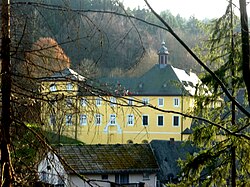Marienthal Abbey (German : Kloster Marienthal) was a Franziscan monastery in the Westerwald in the present-day county of Altenkirchen in the German state of Rhineland-Palatinate. Today Marienthal is a village in the municipality of Seelbach bei Hamm (Sieg). On 30 June 2011 it had a population of 55. [1]
Contents

